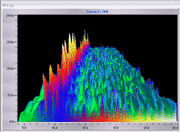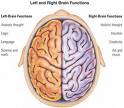Altered
States of Consciousness.

The study of altered state of consciousness
is a science in itself in so far as it
studies the data of a state of changed perception.
An altered state of consciousness is any state which is
significantly different from a normative waking beta
wave state. The expression was coined by Carlos
Castaneda and describes induced changes in one's mental
state, almost always temporary. A synonymous phrase is "altered
states of awareness".
An altered state of consciousness can come about accidentally
through indigestion, fever, sleep deprivation, starvation,
oxygen deprivation, nitrogen narcosis (deep diving), or
a traumatic accident.
It can sometimes be reached intentionally by the use of a sensory deprivation
tank or mind-control techniques, hypnosis, meditation, prayer,
or disciplines (e.g. Mantra Meditation, Yoga,
Sufism or Surat Shabda Yoga). It is sometimes attained through the ingestion
of psychoactive drugs.
Naturally occurring altered states of consciousness include
dreams, lucid
dreams, euphoria, ecstasy,
psychosis as well as purported premonitions, out-of-body
experiences, and channeling.
From Wikipedia, the free encyclopedia
The question is whether it is desirable to have such changed
states of consciousness?
In modern day psychology, one finds a good deal of debate
and discussion on Altered
State of Consciousness brought about by meditation
and contemplation. Significant research work, both in the
Eastern and Western scientific circles, is underway in
this field.
Controversies concerning the brain, mind, and
consciousness have existed since the early Greek
philosophers argued about the nature of the mind-body
relationship, and none of these disputes has been
resolved. Modern neurologists have located the mind
in the brain and have said that consciousness is
the result of electrochemical neurological activity.
There are, however, growing observations to the contrary.
There is no neurophysiological research which conclusively
shows that the higher levels of mind (intuition,
insight, creativity, imagination, understanding,
thought, reasoning, intent, decision, knowing, will,
spirit, or soul) are located in brain tissue (Hunt,
1995). |
Western science of psychology defines altered states of
consciousness (ASCs) as those states in which the individual
feels a qualitative (and also probably quantitative) shift
in the pattern of his mental functioning - both of cognition
and expression. Such a pattern may be clearly observed
closely and reliably in his/her daily life by his/her close
associates or in an experimental settings.
In fact, modern psychologists have documented hundreds of altered
states of consciousness besides the three obvious states: waking, sleeping
and dreaming.
There are hundreds of theories put forth to define consciousness,
but none have fully explained it because it is not physical
even though it manifests through the brain. In fact, the
motory/sensory impressions of an infant, the first consciousness
that humans understand, emerges through the brain and the
nervous system. Modern science has begun to understand
altered states of consciousness as a structural arrangement
of the brain cells and a biochemical process in the brain
I once had a dream
and when i awoke
I did not know whether
I was then a man
dreaming I was a butterfly,
or whether I am now a butterfly
dreaming I am a man.
Chuang-tzu |
 |
Can one
measure consciousness in the brain?
Medical science has been able to measure consciousness
as the product of the brain’s activity. There are
four levels of brain-wave activity with corresponding Greek
letters to designate each: beta, alpha, theta, and delta.
The electroencephalogram (EEG) machine measures these brain-wave
activities.
The Beta Level
The Beta Level defines our normal waking consciousness. Now 75% of waking consciousness
is consumed with monitoring the body's physical functions. The other 25%
of the Beta State deals with the thinking and planning state of the mind.
The brain waves range from 14 to 27 cycles per second.
EEG Recording. Spectrogram View (4-30), ~1.2 minute
time lapse, middle of an Alpha-focused session |
 |
The Alpha Level
The Alpha State is the “resting state” of the brain. It is a passive
state where one is non-critical and non-analytical. Listening to music and
relaxing is reflexive of this state. One is aware of stimuli. Mystical states
of consciousness happens in the alpha state and they usually occur prior to
and just after sleep. The Alpha State also occurs voluntarily during light
hypnosis, meditation, biofeedback, day dreaming, hypnogogic and hypnapompic
states. The brain waves activity range from 8 to 13 cycles per second.
"Mystical states of consciousness happen in the alpha
state ... The Alpha State also occurs voluntarily during
light hypnosis, meditation, biofeedback, day dreaming,
hypnogogic and hypnapompic states."
Dr. Lee Warren, B.A., D.D
"Mystical states of consciousness happen in the alpha
state ... The Alpha State also occurs voluntarily during
light hypnosis, meditation, biofeedback, day dreaming,
hypnogogic and hypnapompic states."
Dr. Lee Warren, B.A., D.D
"If you feel we live in a purely physical universe,
you will view meditation as a good way to obtain a consistent
alpha brain wave pattern" Richard Foster in
Celebration of Discipline
Penfield, an eminent contemporary
neurophysiologist, found that the human mind continued
to work in spite
of the brain’s reduced activity under anesthesia.
Brain waves were nearly absent while the mind was
just as active as in the waking state. The only difference
was in the content of the conscious experience. Following
Penfield’s work, other researchers have reported
awareness in comatose patients (Hunt, 1995) |
Theta Level
The Theta State is the “Reverie State” of conscious that is open
to intuition and inspiration. Now stimuli are often ignored in this state.
Theta occurs during light sleep. It is accessible during biofeedback and meditation.
During this level, one is unaware of one’s surroundings. The brain wave-activity
ranges from 4 to 8 cycles per second.
"...almost everyone has the potential, to one degree
or another, to cultivate shamanic abilities if he or she
wishes to do so. Researchers ... have found that entrainment
of the brainwaves to the alpha and theta rhythms ... induce
similar trance and visionary experiences.
By Sarah Belle Dougherty
(Music and Healing Arts)
The Delta Level
The lowest level of brain activity is the Delta State. In this state the individual
is unreceptive to any stimuli. The Delta State usually occurs during a deep
sleep.
These four levels of brain-wave activity enable science to understand the various
components of consciousness
Left
and Right Brain

Paul Maclean discovered
in his research on the human brain that by far,
most of Western Society never escapes the trap
of the Left Brain and its Ego. Consequently, all
types of illnesses result because of the lack of
contact with the Right Brain, which contains the
Self. Because of the polarity between the Left
Brain and the Right Brain techniques must be used
to make contact between them and begin the Integration
process. |
Left
and Right Brain

LEFT BRAIN
Logical - responsible for logic
functions such as mathematics, computations, logical
deductions
Analytic - examines things
part by part, and relates to small details
Computational - uses sums and
computations to reach estimates
Sequential - does things one
at a time
Factual - deals with details,
items, particulars, features of a thing
Insular - works within the
parameters of the individual's existent data |
RIGHT BRAIN
Imaginative - responsible for
imagination, visualisation and 'open ended' creative
thinking.
Synthetic - arranges the parts
to form the whole; can perceive the whole
Intuitional - uses intuition
to sense or get a feeling of a situation,( including
hunches)
Holistic - does different tasks
at once
things Visual /visuo-spatial - uses imagery, colours; perceives shape
and dimension
'Open-ended' - in touch with,
and can tap into, unlimited 'collective consciousnesses' |

MIND STATES
By connecting a subject to an Electroencephalograph
(EEG), his/her brain waves can be measured in cycles
per second (c.p.s.). This is not so much a quantitative
measure of mental activity as it is of a state of mind.
There are essentially four states - beta, alpha, theta
and delta. Although these have only been scientifically
studied with the advent of modern equipment, I was intrigued
to unearth mention of these four states in ancient eastern
texts. It seems that some ancient societies have long
known how to exploit the mind's unlimited potential.
But whereas in the past such knowledge was limited to
a privileged few, today it has been made more accessible,
and streamlined with modern scientific knowledge.
At an average of 20 c.p.s., the beta state
is the normal, everyday waking state. In this state we
are predominantly engaged in left brain activity. Lowering
the brain wave frequency to around 15 c.p.s. brings us
into the alpha state, and it is here that right brain activity
is engaged. Lower still are theta and delta, but these
do not concern us as they are really only accessed during
sleep. Lowering frequency simply means cutting out unnecessary
stress and brain 'chit-chat'. Besides engaging creative
abilities, this makes the individual more alert,allows
clearer thinking and enables mental faculties which the
beta level does not. Although we talk of lowering frequency,
the effect is more of an altered state.
Go
here To Generate Alpha - Theta waves
We are particularly interested in the alpha
state, as this is where right brain activity can be actively
engaged. This state brings into play our imaginative and
creative faculties, as well as our intuitive mind. It is
the state at which ideas will flow more readily. In everyday
life, we go through alpha at least twice a day - in the
evening as we drift off to sleep, and in the morning when
we wake up. This explains why many top inventions were
conceived early in the morning, or during a state of relaxation.
Einstein came up with the theory of relativity not in his
laboratory but while sunbathing on a hillside. Although
mathematics is predominantly a left brain activity, he
allocated time to relaxing his mind, and advised his students
to do likewise. Nikola Tesla, Thomas Edison, Wolfgang Mozart,
Einstien and other successful thinkers and geniuses employed
similar techniques. Our aim naturally, is to produce alpha
frequencies while fully alert. A state of alpha does not
put one to sleep, on the contrary, it confers a whole spectrum
of benefits.
THE BENEFITS

The following are some of the principal benefits
of right brain activity towards personal effectiveness
of human resources:
1. Enhanced creativity
and imagination
The right brain can be thought of being connected directly to the source of
creativity, and the alpha state is hence more conducive to innovative thinking
and generation of new ideas.
2. Problem-solving
and trouble-shooting
With the mind in a more relaxed state and access to its immense creative resources,
it is naturally better disposed to deal with crisis and solve problems constructively.
3. Less stress
The alpha state has a built-in fringe benefit in that it actually releases
accumulated stress and tension from both body and mind. In our hectic lifestyles,
this makes for more harmonious working conditions on both micro and macro
levels, with resultant improved teamwork, drops in absenteeism, improved
well being and other long-term benefits
4. Heightened intuition
Studies at Harvard revealed that the majority of presidents and managers of
multi-national companies attributed up to 80% of their success to intuition.
Intuition - the legendary hunches and gut feelings of the seasoned businessperson
- can indeed be a very important element in business. Yet because it defies
tangible description, intuition is hardly ever mentioned in conventional
training programmes, with the exception of a few mind dynamics systems. Open-minded,
right brain thinking is highly conducive to intuition, particularly in deep
states of alpha.
5. Easier implementation
of personal change
The quest towards personal effectiveness often involves effecting changes in
disposition or attitude, enhancing constructive traits and eliminating unconstructive
ones, as described earlier. The alpha state very much facilitates these processes.
During powerful workshops that promote change, I often find it useful to induce
states of alpha in order to catalyse new awareness at deeper subconscious levels
of synthesis.
6. Enhanced study /
learning abilities, and memory retention
Another important benefit of right brain patterns is that they greatly facilitate
learning and study, as well as memory retention. This explains the effectiveness
of accelerated learning methods.
7. Better rapport and
negotiation skills
Establishing rapport with others during meetings and negotiations can mean
the difference between agreement or non-agreement, deal or no deal. Even the
most powerful NLP rapport skills work better if one has accessed a state of
alpha. The subject can then be 'paced and led' to follow suit, creating a resonant
state of mind which makes for better bilateral agreement.
8. Other mind skills
Possibly the most outstanding applications of right brain methodology lie in
the use of specialised techniques which present new, often astonishing possibilities.
Examples of applications are the gaining of new mental information, establishing
non-localised rapport, boosting goal achievement through visualisation, solo
brainstorming and mental 'market-testing' of concepts. These are some of
the applications reportedly experienced around the world from light and sound
users. The advantage of these light and sound tools is, that they enable
onewith practice to access a peak performance state at will, a state which
is then gradually integrated into daily life.
You can
encourage the Brain to peak performance
|

